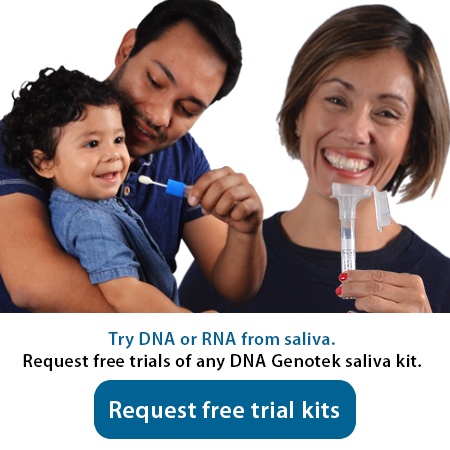2020-01-14
Ten years ago this week, we published DNA Genotek’s first annual top 10 list. In that year, an international group of scientists published the first draft of the Neanderthal genome. We also saw the publication of the genomes of the domestic horse, giant panda, cow, turkey, corn, the Irish potato famine pathogen, and the date palm along with many others. Over the course of the following decade, researchers redrew the map of human migration and interbreeding across the planet by sequencing ancient DNA and comparing it to that of extant populations. Beyond the sequencing of a vast number of genomes, the decade saw changes at an unprecedented pace. To reflect all this change, our top 10 list for 2019 will focus on the changes we saw in the past decade, not just the past year.
1. Adoption of precision medicine in health-care systems
In the past decade, we have referenced precision medicine in almost all of our top 10 lists. We are no longer debating its promises to improve patient outcomes. In the past decade, we witnessed the creation and maturation of the direct-to-consumer genetic testing market. 23andme.com made genetic testing a mainstream service for consumers and many other companies are now offering genetic tests for specific diseases and conditions. Genetic information has become part of our daily lives. Once reserved only for laboratory settings, we have evolved to simply ordering, registering, spitting and reviewing personalized testing results online or with a medical practitioner. We have also seen more clarity around the use of FDA cleared DNA collection devices for laboratory developed genetic tests (LDTs). Every year we see significant progress and new challenges; the past decade has shown that it access to genetic information is becoming ubiquitous. We expect to see further advances in the adoption of precision medicine in the years to come.
2. Emergence of the microbiome
The human microbiome emerged as one of the hottest topics of interest in the scientific community in the past 10 years. In particular, the gastrointestinal microbiome has captured the attention of researchers. In the past decade, we saw the emergence of the first studies focused on methods for collecting stool samples for large, population-based studies. One publication in particular, titled ‘Successful collection of stool samples for microbiome analyses from a large community-based population of elderly men’, took an in-depth look at the collection of stool samples from a large number of older men enrolled in the Osteoporotic Fractures in Men Study (MrOS) using OMNIgene·GUT. The team at DNA Genotek is especially proud to be a leader in this community, contributing innovative products, data and best practices to the research and commercial communities. The benefits of standardization enable microbiologists to aggregate data across studies with confidence, and allow funding agencies to de-risk their investments in this rapidly evolving field.
3. Adding CoreBiome, Diversigen and Novosanis to the family
The decade ended with a bang as our parent company, OraSure Technologies, acquired three companies, all innovators in their respective markets. Our new sister companies will add differentiated products and services to DNA Genotek’s offerings for both the genomics and microbiome markets. The acquisition of CoreBiome and Diversigen creates a comprehensive end-to-end microbiome solutions offering in the market, combining the excellence of DNA Genotek's sample collection and stabilization devices, Diversigen's industry recognized CLIA/CAP state-of-the-art techniques with expert consultative microbiome services, and the strength of CoreBiome's innovative scalable sequencing technology. Novosanis’ urine collection technology expands our molecular collection portfolio and advances DNA Genotek’s expertise in non-invasive sampling. We couldn’t be more excited to add these successful companies to our portfolio of offerings.
UPDATE: On May 12, 2020, CoreBiome rebranded as Diversigen Inc.
4. Beyond DNA and the move to multiomics
As the decade closed, the human genomics community seemed to have focused on one overall theme: going beyond DNA. The focus is no longer merely on human genomics, but how our genome links and interacts to other “–omes”, such as the proteome, transcriptome, epigenome, and microbiome. At this year’s American Society of Human Genomics conference, we surveyed a number of ASHG attendees, asking if they were interested in taking a multiomics approach to their research and 63% said “yes”. It’s clear this is the direction for most researchers and clinicians as we head into the next decade.
5. The revolution in sequencing costs
Over time, DNA sequencing has come a long way, sparking a variety of sequencing revolutions. At the dawn of the decade, with sequencing costs in the tens of thousands of dollars, geneticists were hoping to make genome sequencing a more widespread and affordable reality. As we close the decade, the cost of sequencing has plummeted. Not only did these price drops fuel a consumer market, genome sequencing also gave physicians and researchers an increasingly sophisticated method for diagnosing and studying certain diseases.
6. Sharing big data to accelerate discovery
Big data was another hot topic in the past decade. Data analytics is becoming less of a mystery and is discussed in the hallways and in sessions at most genomics and microbiome conferences. Given that big data is one of the hottest fields on the planet, the future of big data in big pharma and biotech sectors is particularly exciting. Bringing big data to health care will make a difference, at the patient level and at the societal level.
7. Obtaining DNA samples from diverse populations
Genetic inheritance and genetic mutations vary among human populations, including physical environments, race, ethnicity, and more. In the past decade, we’ve learned that there is a strong need to collect samples from diverse populations, outside of North American Caucasian groups, as they are currently not well represented in the genomic databases. Projects such as All of Us and 54gene, have made collecting from diverse populations a high priority to ensure research reflects our differences.
8. The birth of the CRISPR landscape
With the advent of gene editing technology, the ability to add, remove or alter specific sequences of DNA in living cells became a reality. One of the most exciting gene editing tools is CRISPR-Cas9[1], an acronym for Clustered Regularly Interspaced Short Palindromic Repeats and CRISPR-Associated Protein. CRISPR-Cas9 was first harnessed for use in eukaryotic cells in early 2013 by Feng Zhang of the Broad Institute of MIT and Harvard[2]. This technology has the potential to facilitate research, including the rapid creation of transgenic murine models, as well as potentially cure genetic-based diseases[3]. Very recently a new form of the CRISPR system was discovered that specifically targets RNA using the Cas enzyme Cas13b[4]. The ability to edit genes unquestionably has the power to the change the course of the human race.
9. The trend to transformative microbiome research
In this decade, we saw significant advancements in transformative research for the microbiome. If you think of the classic pharmaceutical company drug-development model – it takes many years and billions of dollars to move a novel therapeutic from the drug discovery stage to the post-market surveillance stage. Attrition rates between Phase 1, 2 and 3 can be as high as 50%. Conversely, there are a number of start-up microbiome companies that have successfully moved from proof-of-concept to late-stage clinical trials, in significantly less time and for a fraction of the cost (eg. Vedanta Biosciences, Seres Therapeutics and Indigo Ag). Starting the drug discovery process in humans and accelerating discovery with data science and systems biology is radical. This transformative approach is changing the drug discovery landscape, allowing new entrants and ultimately showing signs that new therapeutics and useful products can be brought to the patients and consumers that need them faster and with reduced risk.
10. Personalized genomics and microbiomics for our pets
We are all aware of the buzz in recent years about direct-to-consumer genetic and microbiome testing but we are also seeing the creation of the direct-to-canine and feline genetic and microbiome testing market. Several companies in this space have launched services for canine breed identification, health and traits based on our Performagene and PerformaBIOME collection kits. These kits use the same principles as our human DNA and microbiome collection kits and offers a simple, non-invasive method for the collection, stabilization and transportation of animal DNA and microbiome samples. So what’s next, lizards, rabbits, and hamsters? We can’t wait to see.
As we said in our first top 10 list in 2010, no article that includes a top 10 list for the year would be complete without mentioning New Year's resolutions. I considered all the usual New Year's resolutions both personally and for DNA Genotek. I even googled the top 10 most popular New Year's resolutions. None of them seemed appropriate. It really comes down to this -- for 2020, I resolve that we will continue to focus on product and service innovation so our customers continue to have the tools they need to make history by finding links that can lead to a cure or new treatment for disease. Multiomics is incredibly complex, but equipped with the right tools, scientists have a unique opportunity for unprecedented exploration into health and wellness. If we can do that, the next decade will be very successful for science. What this will mean is uncertain but the knowledge is sure to contribute to scientific advancement.
References
[1] “What are genome editing and CRISPR-Cas9?”. Genetics Home Reference. S. National Library of Medicine, 17 Apr 2018. Accessed 18 Apr 2018. https://ghr.nlm.nih.gov/primer/genomicresearch/genomeediting.
[2] Cong, Le et al. “Multiplex genome engineering using CRISPR/Cas systems”. Science, 339, no. 6121, pp. 819-23, 2013. doi: 10.1126/science.1231143.
[3] “CRISPR Timeline”. Broad Institute, 2018, Accessed 18 Apr 2018. https://www.broadinstitute.org/what-broad/areas-focus/project-spotlight/crispr-timeline.
[4] Goldsmith, Paul. “Researchers harness novel RNA-targeting CRISPR system”. Broad Institute, 5 Jan 2017. Accessed 18 April 2018. https://www.broadinstitute.org/news/researchers-harness-novel-rna-targeting-crispr-system.


